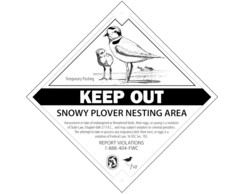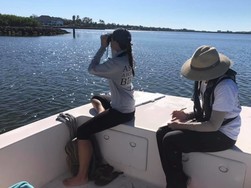FSA Partnership Meetings:
March 2: St. Johns/Flagler Partnership. Email Hailey Garcia.
March 3: Space Coast Partnership. Email Anna Deyle.
March 8: Volusia County Partnership. Email Jaymie Reneker.
March 14: Florida Keys Partnership. Email Suzy Roebling.
March 16: Suncoast Partnership. Email Holley Short.
March 20: Collier-Lee-Charlotte Counties Partnership. Email Collette Lauzau.
Florida Shorebird Database (FSD) Training:
March 7, 1-2:30pm (EST): FSD webinar for new route surveyors.
March 8, 1-2:30pm (EST): FSD webinar for returning route surveyors.
March 9, 1-2:30pm (EST): FSD webinar for new and returning rooftop monitors.
REGISTER HERE
The 2023 Shorebird Breeding Season is Here!
This newsletter is all about helping you engage in shorebird conservation and monitoring during the 2023 breeding season. Your local partnership is organizing many activities, so please coordinate with them. The best way to do that is to attend a partnership meeting. If you can’t attend the meeting but would like to get involved, please contact shorebird@myfwc.com. Here are a few ways to get started:
Be a mentor, or team up with one. Does your partnership have new members? If so, encourage them to join a local bird steward program or bring them along on a monitoring survey. If you're a new member, check with your partnership for training and mentoring opportunities.
Get posting supplies. Do you have the posting supplies you need to cover your areas? Let your FWC regional shorebird contact know if you need signs or supplies. View our sign selection.
Get outreach materials. The FSA website contains helpful materials to support your outreach efforts. View the available resources and contact your FWC regional office to receive supplies.
Prepare for route surveys. If you have an assigned route, will you be able to survey it during all six count windows? If not, please work with your partnership to find someone to fill in for you or contact us for help. Remember to coordinate survey plans with your local partnership and register for a route or rooftop training webinar.
Prepare for rooftop monitoring. Can you help monitor rooftops with nesting birds? If so, coordinate with your partnership or contact us. Please let us know if roofs are no longer suitable for nesting (ex: building was torn down or re-roofed).
Read on for more details about getting involved this season...
Collage photos: Jean Hall; Critical wildlife area posting photo - Michelle van Deventer

Posting Breeding Sites
Posting is the process of installing signs and rope to create symbolic fencing around shorebird and seabird breeding habitat to protect breeding adults, nests, chicks, and brood-rearing activities. Posting is often the best tool to protect shorebirds and seabirds from human disturbance on popular beaches and islands. To support birds in establishing territories and courting, when feasible, it is recommended to post an area before nesting begins. Detailed posting guidance can be found in the 2021 Guidelines for Posting Shorebird and Seabird Sites in Florida.
If you find a shorebird nest or seabird colony that has not yet been posted, please notify the local land manager or an FWC regional shorebird contact immediately so that it can be posted. Parks usually have their own preferred signs and posting materials, but if not (or if the nest is on private property), supplies and assistance can be requested by contacting your FWC regional shorebird biologist. Check out our sign selection – many can be printed off and laminated.
Before posting, consult with local managers and the Florida Fish & Wildlife Conservation Commission, and ensure that a monitoring plan is in place. Posting impacts local activities and has legal implications and is a cooperative effort between FSA partners.
|

Bird Stewarding
At some sites, a significant barrier to successful breeding is disturbance from people, pets, and vehicles in the nesting area. Signs posted around the nests are not enough to prevent disturbance to breeding birds. In these circumstances, disturbance minimization requires additional effort from caring individuals known as bird stewards to monitor the nests and chicks.
Bird stewarding begins after nests and colonies are located and posted by biologists. While out on the beaches, stewards carry out two important tasks: 1) minimizing disturbance to the nests, and 2) educating visitors on Florida's breeding shorebirds and seabirds. Although the greatest need for stewards is on weekends and holidays, stewarding can be done anytime an area has active shorebird nesting.
Shorebird steward programs are organized by shorebird partners throughout Florida. Where and when bird stewards will be needed is not fully determined until the birds have started nesting. This usually starts in March and can run into September, depending on the bird species.
To volunteer as a bird steward this season, please check this map to see if there is a steward program near you. If so, please call or email the program contact to get involved. If there is not a bird steward program near you and you are interested in starting one, please contact us.
Photo: Jean Hall
|

Breeding Bird Surveys and Training
Florida’s official shorebird monitoring program begins this month, with the first count window from March 18th – 24th. Everything you need to know to participate in the monitoring program can be found on the Florida Shorebird Database (FSD) website.
The website’s Instructions detail what the monitoring program involves. The Resources page contains videos on data entry and the Breeding Bird Protocol (BBP), which explains the monitoring process and includes data sheets.
All monitors are encouraged to register for a training webinar. The March 7th webinar is for new volunteers who plan to survey a specific route (usually along the beach). The March 8th webinar is for returning volunteers and includes updates to the BBP and FSD interface. The March 9th webinar is for volunteers who plan to monitor rooftops and focuses the rooftop section of the BBP and FSD interface. Details and instructions will be emailed to registered participants prior to the webinars.
All webinars are from 1-2:30pm Eastern.
Register here for the 2023 webinars.
Photo: Holley Short
|

Rooftop Monitoring and Outreach
Many seabirds and some shorebirds nest on gravel rooftops in Florida, making rooftop monitoring and outreach important components of our work. There are hundreds of rooftops throughout the state where seabirds have historically nested, and we need your help monitoring them. If you would like to become a monthly rooftop monitor, March - August, please review the rooftop section of the Breeding Bird Protocol and contact your local partnership to get involved.
At rooftops where birds nest every year, there are many way you can help improve the birds' breeding efforts:
- Review the Rooftop Resources section of the FSA website and download letters, postcards, signs and other outreach materials that support your outreach efforts.
- Talk to the property owners or managers early in the season to help make them aware of the protected species nesting on their roof; remind them to schedule rooftop repairs or air conditioning maintenance before the birds arrive.
- Leave contact information for building employees or residents to call in case of fallen chicks or other issues.
- Work with your local partnership to help with chick-proofing, chick-checking and to notify us of rooftops with new nesting.
photo: Jean Hall
|

The Florida Shorebird Database is Open for the Season!
The breeding season is here and the first Breeding Bird Protocol Count Window is March 18-24. Before entering your breeding data, you may want to do a little spring cleaning of your Florida Shorebird Database (FSD) account:
- Review the 2023 Breeding Bird Protocol. We clarified the language about additional adults breeding on the route, so be sure to check it out!
-
Log in to your FSD account.
- Make sure your contact information, data entry permissions, and partnership affiliations are up-to-date by clicking Manage Account.
- Review your list of routes and rooftops.
- Are you still planning to survey the routes and rooftops listed in your profile? If not, you may want to remove them from your profile.
- Are the descriptions for the routes and rooftops accurate? If not, you can update the information by clicking ‘View/Edit’, then editing the Description.
- Are the routes and rooftops still suitable for nesting? If not, email FLShorebirdDatabase@myFWC.com to retire them.
Thank you for your dedication to shorebird and seabird conservation. May the 2023 nesting season be highly productive!

2023 Winter Shorebird Survey Data
Today is the last day to enter data from the Florida Winter Shorebird Survey. Enter your data in the Winter Birds 2023 Google Sheet. If you are unable to complete data entry today, please email shorebird@myfwc.com for support. Thank you for continuing to support the annual snapshot of shorebirds and seabirds wintering in Florida.
Photo: Jack Rogers
|
|